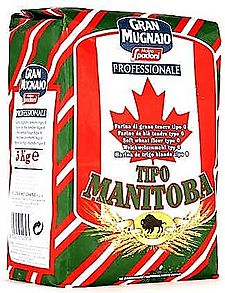Manitoba flour facts for kids

Gran Mugnaio Tipo Manitoba
|
|
| Type | Flour |
|---|---|
| Place of origin | Canada |
| Region or state | Manitoba |
Manitoba flour is a special type of flour. It is mostly known and used in Italy. This flour comes from a kind of wheat grown in Manitoba, a large area in Canada.
People call it a "strong" flour. This means it is different from "weak" flours. The strength of flour is measured using a special number called the "W value." The higher this W value is, the stronger the flour. For example, a weak flour has a W value less than 170. Manitoba flour, however, has a W value higher than 350.
Contents
What is Manitoba Flour?
This special flour gets its name from where it first came from. It was grown in Manitoba, a huge province in Canada. The wheat grown there was very strong and could handle cold weather. The name "Manitoba" itself comes from "Manitou". This is a word used by some Native American groups for a powerful life force.
Today, any flour that has a W value higher than 350 is called manitoba flour. It does not matter where the wheat was grown or what type of wheat it is.
How is Manitoba Flour Used?
Manitoba flour has a lot of special proteins. These proteins are called glutenin and gliadin. When you mix this flour with water, these proteins create something called gluten. This means Manitoba flour is rich in gluten but does not have much starch.
Why Gluten is Important
Gluten forms a stretchy net in dough. When you make bread or other baked goods, this net traps the gases from yeast or other leavening. This helps the dough grow big and fluffy when it bakes.
For pasta, gluten helps keep the dough firm. It stops the starches from making the pasta sticky. This allows pasta to be cooked al dente, which means it is firm to the bite.
Common Uses for Manitoba Flour
You can find Manitoba flour in stores for home baking. Bakers, pastry chefs, and pizza makers also use it. In Italy, most pasta is made from a different type of wheat called durum wheat. But in other countries, Manitoba flour is used to make egg-based pasta.
Flour mills often mix Manitoba flour with other flours. This helps to make the overall flour stronger. Dough made with Manitoba flour is more stretchy and strong. This makes it great for special kinds of bread, like French baguettes. It is also used for sweet breads like panettone and pandoro.
Manitoba flour is also good for pizzas that need a long time to rise. It is used in some traditional cakes, like ciaccia or Easter cheese cakes.
Special Baked Goods
Because it is so strong and stretchy, Manitoba flour is perfect for many complex recipes. It is especially good for sweet baked goods that need to rise a lot. Think of croissants, doughnuts, and baba. It also works well for savory items like focaccia genovese. Some types of bread, like chapati from India, also use this flour.
Manitoba flour is also used to make Seitan. This is a food that some vegetarians and vegans eat for protein.
See also
 In Spanish: Harina Manitoba para niños
In Spanish: Harina Manitoba para niños

